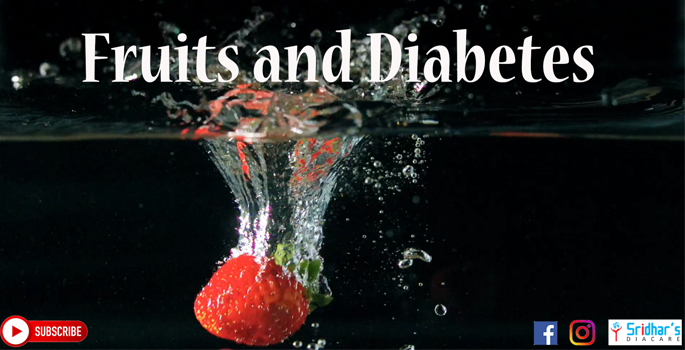
The famous holistic health practitioner Ann Wigmore once said – “The food you eat can be either the safest and the most powerful form of medicine or the slowest form of poison.” So we need to make the right choices when it comes to what we eat or must eat.
You must have heard that you can’t eat fruits if you have diabetes. But actually, whole fresh fruit is packed fully with fibre, vitamins, minerals and antioxidants making it a nutrient-dense food group that can certainly be a part of a healthy diabetes treatment plan. People with diabetes should be cautious however as certain fruit choices may affect blood sugar levels more than others. It is important to learn which fruit affects you the most, how to make choices of which fruit to consume and its portion sizes etc.
How does eating a fruit affect blood sugar?
The sugar found in fruit is called fructose. Fructose gets metabolised quickly by the liver. In the process of its breakdown, fructose is capable of bypassing an enzyme that signals when cells have had too much sugar. Skipping past this limiting step is a danger when consuming a lot of fructose at once. Fresh fruit is full of fibre, vitamins, minerals and antioxidants which may all work together to support healthy glucose regulation. Fibre found in fruits, both soluble and insoluble can help prevent blood sugar spikes by slowing down the metabolism process. It may cause an essence of fullness and results in less food intake. Fresh whole fruit has the most fibre because the cell walls are intact. Cooking based on the fibre structures in the fruit and thereby the sugar is more readily available for absorption and thereby raise the blood sugar levels.
Fruits also contain high amounts of antioxidants. It is seen more in fruits with darker colours such as deep reds, purples, blues etc. These antioxidants are plant-based compounds that work to fight free radicals in the body helping the body repair itself from all stress. Fresh or frozen fruits are better than processed fruits straight from a can or jar such as apple cause or canned fruit. People with diabetes should avoid processed foods or fruits completely. The body absorbs processed fruits more rapidly leading to higher blood sugar levels. Processing fruit also removes or reduces the levels of certain key nutrients including vitamin and fibre. Diabetics should avoid fruit juices or canned fruits with added sugar.
It is always safe to choose your regular fruit based on its glycemic index. Glycemic index is the rating of foods on a scale of 1 to 100. This score indicates how quickly the food or fruit will raise blood sugar levels. High glycemic index foods are absorbed faster than medium or low glycemic index foods. Glycemic load takes into account the glycemic index of food plus the number of carbohydrates in a serving. So glycemic load is a more accurate way of assessing how food affects blood sugar management over time. Low glycemic index or low glycemic load foods are better for helping control blood sugar levels.
Which are the common fruits with low glycemic load and low glycemic index that can safely be consumed by diabetic patients?
They are
- Apples
- Avocdos
- Cherries
- Berries
- Kiwi fruit
- Oranges
- Pears
- Plums
- Peaches
- Strawberries
- Papayas etc
Bananas can also be consumed in moderation. Bananas contain potassium and tryptophan – an important amino acid. Citrus fruits like oranges and musambis are high in vitamin A and C which are powerful antioxidants.
How much fruit can I take in a day?
It is a common myth that if you have diabetes you shouldn’t eat certain fruits because they are too sweet. Some fruits do contain more sugar than others but that doesn’t mean that you shouldn’t eat them if you have diabetes. It is the total amount of carbohydrates in the food that affects blood sugar levels more than the source of carbohydrates, whether the source is starch or sugar. One serving of fruit should contain 15 grams of carbohydrates. The size of the serving depends on the carbohydrate content of the fruit. So the advantage of eating a low carbohydrate fruit is that you can consume a larger portion. Whether you eat a low carbohydrate or high carbohydrate fruit, as long as the serving size contains 15 grams of carbohydrates, the effects on your blood sugar is the same.
Fruit should be a part of the diabetic diet, but pay attention to the portion control which is about 15grams per serving. And also make sure to count the fruit as a carbohydrate in your meal plan. Diabetics are not advised to take fruit juices regularly. Eating whole fruit with dietary fibre is recommended over juice. The fibre in the whole fruit delays digestion. This delay will not only help you feel full, but it will also not raise your blood sugar levels as quickly as in a fruit consumed in juice form.
To briefly tell you what a correct portion size in a fruit serving that contains 15 grams of carbohydrates is as follows
About half a medium apple, a small banana, 1 cup blackberries, 1 and ¼ cup of strawberries, ¾ cup of blueberries, 10-15 small grapes, 1 kiwi fruit, 1 pear, 1 orange, 1-2 apricots, 1 cup cherries, 1 or 2 peaches etc.
Adopting a new healthier lifestyle can involve changing diet to include more fresh fruits and vegetables as well as increasing levels of exercise. To conclude I must say, fruits and vegetables do not fight disease, it is their absence that causes disease.
Now if you want to have a look at the Malayalam version of the video, please check the video below.

